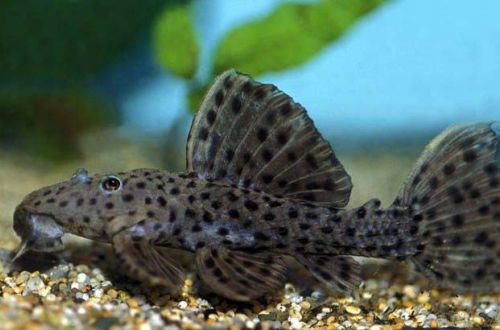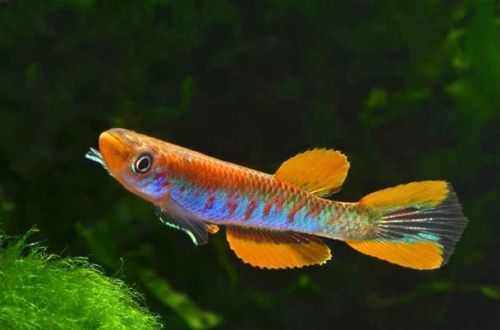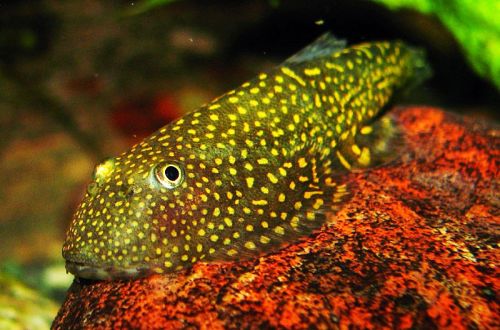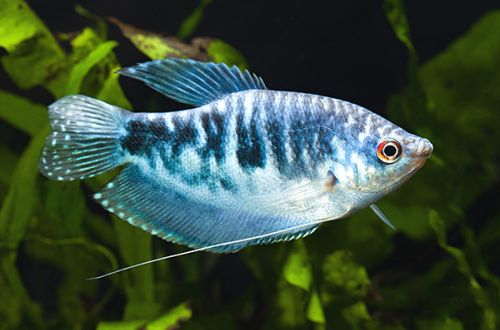
Spiny plecostomus
Pseudoacanticus deluxe or Spiny plecostomus, scientific name Pseudacanthicus spinosus, belongs to the family Loricariidae (Mail catfish). The catfish is native to South America. The natural habitat extends to the vast Amazon basin.

Description
Adults reach a length of about 26 cm. However, in an artificial environment in spacious tanks they can grow much larger. According to some reports, the maximum size sometimes reaches 40 cm.
Catfish has a somewhat flattened body with large fan-shaped fins. The integument of the body is hard, rough and covered with rows of sharp spines, which is reflected in the name of this species. In addition, the first rays of the fins are noticeably thicker than the rest and are sharp spikes, also studded with small spines.
A characteristic feature of the body pattern is evenly spaced rounded dark specks. Depending on the specific geographical form, the color varies from yellowish to almost black.
The mouth is a suction cup located on the bottom of the head. The teeth are not numerous, but very strong and are designed for cracking the shells of river mollusks.
Behavior and Compatibility
The behavior model is quite complex. The spiny plecostomus is jealous of defending its territory. With a lack of space, two adult catfish may not have enough free space and then mutual aggression cannot be avoided. A similar situation will inevitably arise in the neighborhood with other territorial species. It is recommended to proceed from the minimum required bottom area of 0.6 m² per catfish.
If the need for territory is satisfied, then, as a rule, manifestations of hostility are not observed. Peacefully tuned in relation to fish of comparable size, living in the water column or near the surface.
Brief information:
- The volume of the aquarium – from 250 liters.
- Temperature – 23-28°C
- Value pH — 5.8–7.5
- Water hardness – 2–18 dGH
- Substrate type – any
- Lighting – subdued
- Brackish water – no
- Water movement is weak
- The size of the fish is about 26 cm.
- Nutrition – sinking feed with a predominance of protein components
- Temperament – quarrelsome, show territorial behavior
- Keeping alone in small aquariums
Maintenance and care, arrangement of the aquarium
The optimal dimensions of the aquarium for keeping one adult Pseudoacanthus deluxe start from 250–300 liters, provided that the bottom area is not less than the mentioned 0.6 m² (for example, 120 × 50 cm).
The design welcomes the presence of shelters of a suitable size – large snags, rock structures, boulders, artificial caves, etc. It is most active in low light conditions, for example, after the lights are turned off. If the light level is not critical for the rest of the inhabitants of the aquarium and plants, then you can initially set low lighting or shading with clusters of floating plants.
Acclimatized fish are able to successfully adapt to a fairly wide range of conditions, primarily pH and dGH. However, slightly acidic or neutral water of medium hardness is considered comfortable.
Long-term successful keeping is largely determined by the aquarist’s ability to maintain a stable habitat with suitable conditions for the species. In achieving this goal, regular maintenance of the aquarium and the smooth operation of the equipment, especially the filtration system, are crucial.
Food
In nature, various invertebrates (mollusks, worms, aquatic insects and their larvae, etc.) serve as the basis of the diet. In the absence of the usual food, they can eat various plants, fruits that have fallen into the water and other plant organic matter. In general, it is an omnivorous species, but with a predominance of protein components in the diet. In a home aquarium, it is also worth serving sinking dry foods rich in protein, live or frozen foods, such as bloodworms, pieces of mussels, shrimp, etc. Pieces of vegetables (cucumber, zucchini, eggplant, etc.) can be used as additives.





